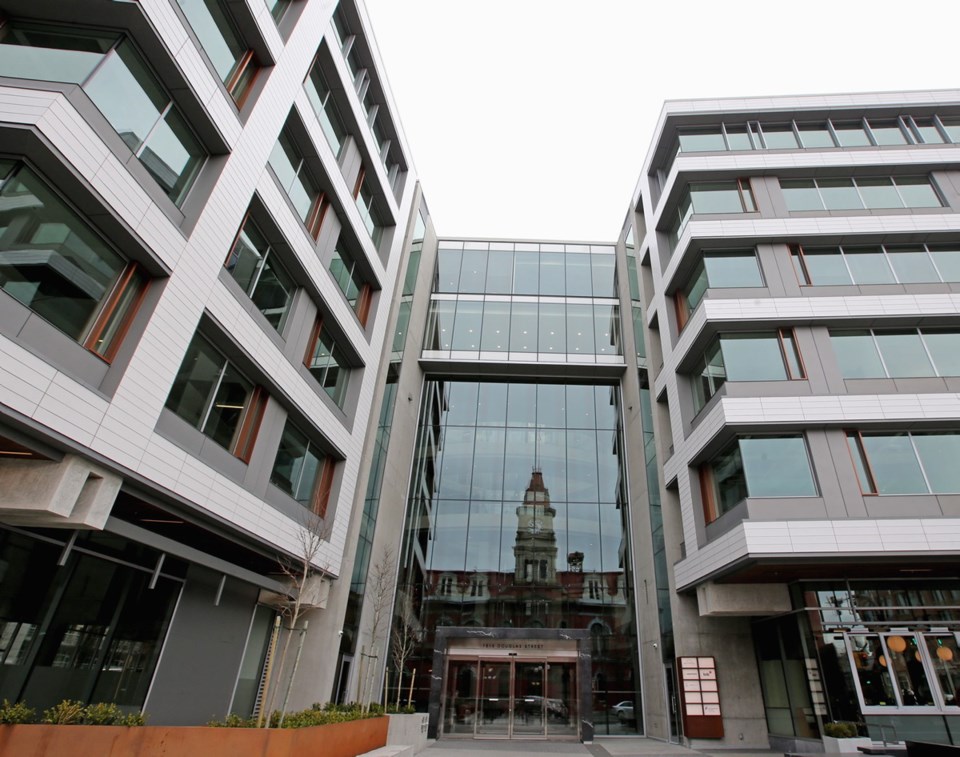Victoria’s office market appears to have been left relatively unscathed by the COVID-19 pandemic, but the vacancy rate is still on the rise as more downtown offices have moved to new digs around the region.
According to a new office market report from Colliers International the vacancy rate for office space in the region increased to 5.9 per cent at the end of the second fiscal quarter, up from 5.1 per cent in the first three months of this year.
That’s largely due to two provincial ministries moving lock, stock and stapler to the Capital Park development in James Bay, according to Colliers vice president Tristan Spark, who noted 80 per cent of the 70,000 square feet of newly available office space downtown resulted from the moves.
Spark said new projects, like the $250 million mixed-used Capital Park development, offer new Class A office space and spur on a flight to quality, which tends to leave older Class B and C buildings vacant or available at lower rents to other businesses or ripe for redevelopment.
The report suggests the vacancy rate will remain fairly stable for the rest of this year, likely getting to 6.3 or 6.5 per cent by the end of the year.
Spark said it could climb to about seven per cent at some point before things normalize, but he points out even at that point the city will be in good shape as its 10-year average occupancy is about eight per cent.
The reason the vacancy rate is expected to remain stable, according to Spark, is the success the province has had in dealing with the pandemic.
“It didn’t really affect offices too much,” he said.
It did result in many government offices and Crown agencies directing their staff to work from home for the foreseeable future, while high-tech firms and other companies that could did the same.
The move to work remotely drastically changed the traffic pattern and sheer number of people on the street in the downtown core, but it didn’t translate into much office vacancy.
Spark said that’s down to companies and government still needing space for employees who can’t or don’t feel comfortable working from home.
“There will always be a need for office space,” he said, noting it may be fine for people working at home now, but that is bound to change in the winter or after the novelty wears off after a year or two. “I don’t think the office is going anywhere.”
He said from what he’s seen government is sticking with more or less the same footprint, but having fewer people in each floor plate to allow for social distancing.
Some companies that had expanded are now considering sub-leasing their extra space and maintaining their current size.
“Over the last 10 years the trend has been to have open concepts and increased employee density. That’s over,” said Spark, adding there will now be more options on the table including working from home for employees. “There will be a return now to traditional offices and more private offices.”
According to the province, which occupies a massive footprint in the downtown, public service workplaces are expected to continue operating with reduced occupancy capacity to allow for social distancing.
Ministries will continue to find a balance of in-office and remote work, and will support employees who choose to work from home where the nature of their work allows for it.
At the same time, some offices have been expanded and reconfigured to allow more workers to return to the ministry buildings while having space for social distancing.
The Colliers report points out there is still plenty of space on the way to market, with 204,000 square feet of office space currently under construction and another 419,000 square feet in various planning stages, like the massive Telus-Ocean building planned for the Apex lot downtown.
Spark said as those developments come to the market, the new space is likely to be snapped up and the older space taken over by the burgeoning tech sector or other businesses and in some cases bought by developers to add more residential units.
“Historically that’s what happens,” he said.
In the short- and medium-term, however, the retail space is expected to feel the squeeze in the downtown especially.
Spark said retail has certainly taken more hits than office space so far, and he’s had some clients opt to downsize their current locations to find more affordable retail space downtown.
“Retail will suffer more and I’d expect to see more of that space on the market in the third and fourth quarter of this year,” he said.



